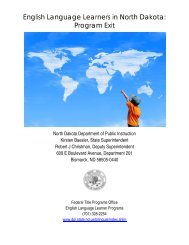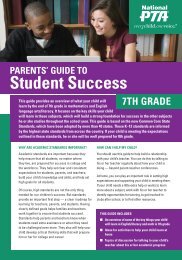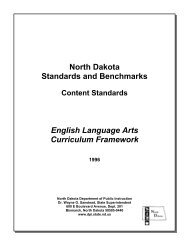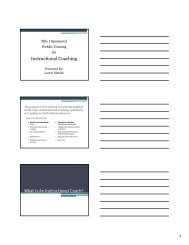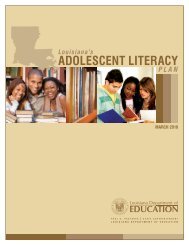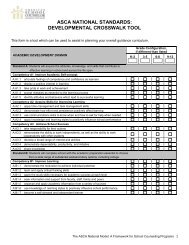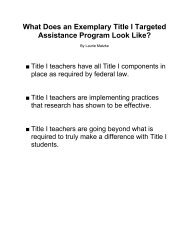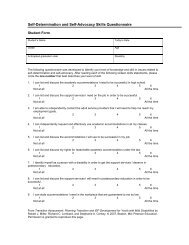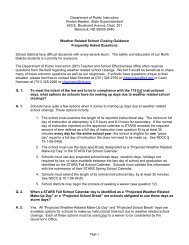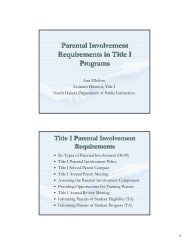Fifteen Effective Strategies for Improving Student Attendance
Fifteen Effective Strategies for Improving Student Attendance
Fifteen Effective Strategies for Improving Student Attendance
You also want an ePaper? Increase the reach of your titles
YUMPU automatically turns print PDFs into web optimized ePapers that Google loves.
Gardner, H. (1993). Multiple intelligences: The theory in practice. New<br />
York: Basic Books.<br />
Pauley, J. A., Bradley, D. F., and Pauley, J. F. (2002). Here’s how to<br />
reach me: Matching instruction to personality types in your classroom.<br />
Baltimore: Paul H. Brookes Publishing Co.<br />
Strong, R., Silver, H., Perini, M., & Tuculescu, G. (1998). Boredom<br />
and its opposite. Retrieved October 9, 2003, from http://<br />
www.ascd.org/publications/ed_lead/200309/strong.html<br />
Truancy reduction ef<strong>for</strong>ts: A best practices review. (2000, Fall). Spectrum:<br />
The Journal of State Government, 73(4), p. 13+. Retrieved<br />
October 12, 2001, from Expanded Academic ASAP. Article<br />
A68742489.<br />
Model Programs<br />
The High/Scope Approach is an activity-based academic learning<br />
model <strong>for</strong> youth between the ages of 14 and 17. It is a youthcentered,<br />
developmentally responsive framework <strong>for</strong> working with<br />
adolescents that includes meaningful choice, active learning, plando-review,<br />
choice, cooperative learning, and leadership development.<br />
This framework prepares teachers to share responsibility <strong>for</strong> learning<br />
objectives with students. Teachers provide opportunities <strong>for</strong> students<br />
to make meaningful choices in planning their own projects to<br />
meet learning objectives. The High/Scope Approach was developed<br />
and research-validated at the Institute <strong>for</strong> IDEAS—a four-week summer<br />
program <strong>for</strong> educational enrichment and leadership development.<br />
Studies demonstrated that students who attended the institute<br />
<strong>for</strong> IDEAS were more likely to complete high school and subsequently<br />
pursue postsecondary education than were those who did<br />
not attend the Institute. The approach is now used in numerous<br />
youth-servicing programs and has been most comprehensively<br />
implemented at Lakewood Educational Alternative Program (LEAP),<br />
a small alternative education high school in Lake Odessa, Michigan.<br />
Contact: High/Scope Educational Research Foundation; 600 North<br />
River Street; Ypsilanti, MI 48198; telephone: 734-485-2000 ext. 266;<br />
fax: 734-485-0704; email: info@highscope.org http://<br />
www.highscope.org<br />
Alee Academy: A Progressive Alternative Education Charter<br />
School, Lake County School District, in Southside Shopping Center,<br />
Umatilla, Florida, challenges students to fulfill their academic and<br />
personal potential. The purpose of Alee Academy is to provide at-risk<br />
students, adjudicated youth, and <strong>for</strong>mer dropout students the opportunity<br />
to develop vocational skills, gain employment, and earn a high<br />
school diploma through credit recovery and the GED Exit Option Program<br />
in a nontraditional learning environment. Instructional methods<br />
include direct teacher instruction, one-on-one tutoring, computerassisted<br />
learning, field trips, individualized instruction, collaborative<br />
learning, and work site training. A martial arts curriculum provides<br />
an effective means <strong>for</strong> enhancing the motivational climate of the<br />
educational experience. Other unique programs are the sandwich<br />
shop, the ropes course, and the boat-building program. Through partnerships<br />
with local businesses, the students are aware of and utilize<br />
resources that exist beyond the school setting. Graduation rates and<br />
test scores have increased each year that Alee has been in existence.<br />
Crystal Star Award of Excellence in Dropout Recovery, Intervention,<br />
and Prevention, 2002 winner. Contact: Jennings Neeld, Director; Alee<br />
Academy; P.O. Box 2481; 755 South Central Avenue; Umatilla, FL<br />
18<br />
32784; telephone: 352-669-1280; fax: 352-669-1282; email:<br />
AleeAcademy@lake.k12.fl.us. http://aleeacademy.org/<br />
Web Sites<br />
• The Association <strong>for</strong> Supervision and Curriculum Development<br />
(ASCD) is a unique international, nonprofit, nonpartisan association<br />
of professional educators whose jobs cross all grade levels<br />
and subject areas. Founded in 1943, ASCD’s mission is to<br />
<strong>for</strong>ge covenants in teaching and learning <strong>for</strong> the success of all<br />
learners. http://www.ascd.org/<br />
• The International Learning Styles Network fosters lifelong academic,<br />
intellectual, and personal success through the promotion<br />
and dissemination of research, in<strong>for</strong>mation, publications<br />
and other resources focusing on learning, teaching, and productivity<br />
styles. http://www.learningstyles.net/<br />
• The National Society <strong>for</strong> Experiential Education (NSEE) is a nonprofit<br />
membership association of educators, businesses, and community<br />
leaders. Founded in 1971, NSEE also serves as a national<br />
resource center <strong>for</strong> the development and improvement of experiential<br />
education programs nationwide. http://www.nsee.org/<br />
• The National Society <strong>for</strong> Experiential Education (NSEE) is a nonprofit<br />
membership association of educators, businesses, and community<br />
leaders. Founded in 1971, NSEE also serves as a national<br />
resource center <strong>for</strong> the development and improvement of experiential<br />
education programs nationwide. http://www.nsee.org/<br />
Educational Technology<br />
General Definition<br />
Technology offers some of the best opportunities <strong>for</strong> delivering<br />
instruction to engage students in authentic learning, addressing<br />
multiple intelligences, and adapting to students’ learning styles.<br />
Technology can reduce the educational disparities created by<br />
race, income, and region; and accommodate differences in learning<br />
(Imel, 1999).<br />
Publications<br />
Foltos, L. (2002). Technology and academic achievement. Seattle, WA:<br />
New Horizons <strong>for</strong> Learning.<br />
Imel, S. (1999). Using technologies effectively in adult and vocational<br />
education. Practice Application Brief, 2. Retrieved March 17, 2005,<br />
from http://www.cete.org/acve/docgen.asp?tbl=pab&ID=92<br />
School safety & security. (2005, January 1). Retrieved March 17, 2005,<br />
from: http://www.eschoolnews.com/news/showStory.cfm?<br />
ArticleID=5449<br />
Sweet, J. R. (2004, November). Case studies of high-per<strong>for</strong>ming, hightechnology<br />
schools: Final research report on schools with predominantly<br />
low-income, African-American, or Latino <strong>Student</strong> populations.<br />
Retrieved March 16, 2005, from http://www.ncrel.org/tech/<br />
hpht/hpht.htm<br />
U.S. Department of Education. (2003). Power of the Internet <strong>for</strong> learning:<br />
Moving from promise to practice. Retrieved March 16, 2005,<br />
from, http://www.ed.gov/offices/AC/WBEC/FinalReport<br />
Research Report




